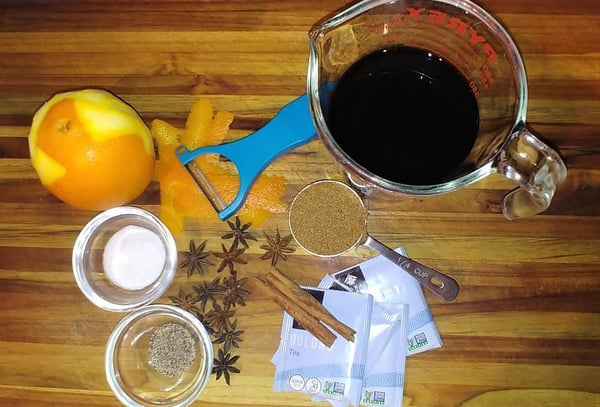Marbled Tea Eggs

Happy New Year of the Tiger! I love when my blog posts coincide with the Chinese Lunar New Year. We lived in Beijing from 1997-2000, and this celebration remains close to our hearts. It was always a time when the local families we had come to know were proud to teach us their traditions, from food to fireworks to visiting relatives. We absorbed the local customs with joy, learning as much as we could since we knew our time there was limited. Upon returning to the U.S., this is the one holiday we continued to celebrate, sharing the foods we came to love with our friends.
In that same spirit of sharing traditions, I’d like to show you a fun and super-simple recipe for Marbled Tea Eggs. These pretty and flavorful hard-boiled eggs are a popular street food year-round. However, they make an especially noted appearance during the Chinese New Year since their round shape signifies the good luck we all want the new year to bestow. I vividly remember seeing these eggs floating in their fragrant broth at the street food markets and can recall my first taste so well: subtle salty-sweet with scents of orange and anise. I just love these and they are so easy to make. I hope you’ll give them a try!
Marbled Tea Eggs
You will need:
- 12 white-shell eggs, room temperature + cold water for simmering (I use white-shell eggs simply for the convenience of being able to see the coloring “take” onto the outside of the shell. If you use eggs of any other color, it will definitely not impede the marbling process; you just won’t be able to see the coloring on the outside of the shell as readily.)
Tea liquid for steeping:
- 10 cups of cold water
- 5 cups of soy sauce (tamari works for a gluten-free option)
- 1/4 cup dark brown sugar
- 2 teaspoons granulated sugar
- The rind from an orange, peeled into wide strips using a peeler (save the orange for another use)
- 10 whole star anise pods
- 2 cinnamon sticks
- 2 teaspoons salt
- 2 teaspoons coarsely ground black pepper
- Bagged black tea of your choice (I like using oolong or lapsang souchong tea)
I’ve been making these for a lot of years now, and my recipe has grown and changed with time. At one point I added Five Spice Powder, but I found it didn’t always dissolve well and left a residue I didn’t care for on the eggs. I’ve tried both bagged tea as well as loose tea and, while both work, I found I liked using tea bags better. While it may be less traditional, it was just easier not having loose tea leaves sticking to the shells of the eggs once I removed them from the tea liquid. In addition, it made for one less step if I decided to save the liquid, since I didn’t have to strain out the tea leaves. I’ve experimented with different black teas and have found my favorites are oolong and lapsang souchong since they result in woody/smoky flavors, with lapsang souchong being the smokier of the two. Today I used oolong tea bags.
One more thing I’d like to note is that while I prefer my hard-boiled eggs on the “just hard” side, with tender yolks and most definitely without that greenish circle around the yellow yolk, these eggs won’t give you that result. It’s just the nature of how they’re prepared. These eggs are simmered, then crackled, then simmered some more and left to steep and cool in the tea liquid. While infused with amazing flavor, these are definitely all about the pretty marbled & flavorful whites. That’s not to say that the yolks are inedible! Quite the contrary, really, they have as much flavor as the rest of the egg – they just aren’t as “pretty and tender” as you might be used to seeing in your everyday hard-boiled egg adventures!
So, let’s start with the eggs. Place them in a single layer in a pot with an available cover. Your pot should be deep enough that it will ultimately hold the eggs plus 3 quarts of liquid. At this point though, you just need to add enough cold water to cover the eggs by about an inch. I find that if the water level comes to the first knuckle on one of my fingers when I hold it on the side of an egg, it’s the perfect amount.
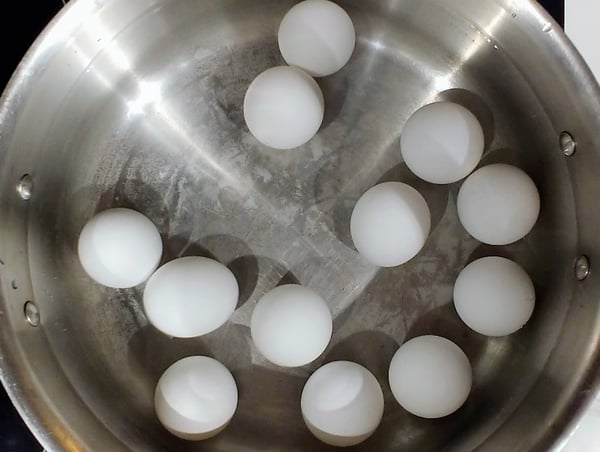 Bring the water to a boil over high heat. As soon as the water starts to boil, remove the pot from the heat, cover it and let the eggs stand for 10 minutes. In the meantime, prepare a bowl with an ice water bath. Make sure you use plenty of ice because it will melt quickly once you add the hot eggs. Once the eggs are done sitting in the hot water, use a slotted spoon or spider to transfer the eggs to the ice water bath.
Bring the water to a boil over high heat. As soon as the water starts to boil, remove the pot from the heat, cover it and let the eggs stand for 10 minutes. In the meantime, prepare a bowl with an ice water bath. Make sure you use plenty of ice because it will melt quickly once you add the hot eggs. Once the eggs are done sitting in the hot water, use a slotted spoon or spider to transfer the eggs to the ice water bath.
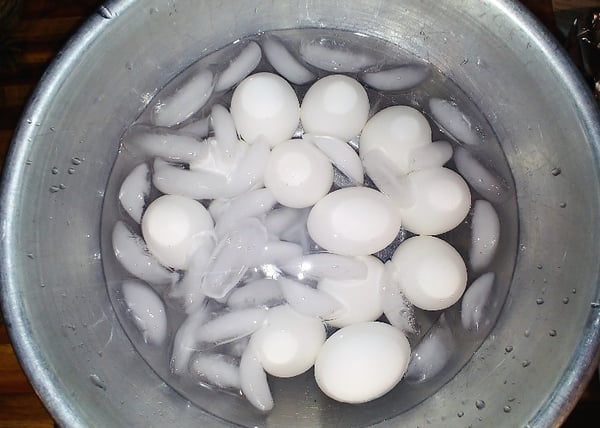 It will take just a few minutes for the eggs to cool so that you can easily handle them. Once they’ve reached that point, remove them from the ice bath and dry them off. Rinse out the pot and place it back on the stove. You will be using it again in a few minutes.
It will take just a few minutes for the eggs to cool so that you can easily handle them. Once they’ve reached that point, remove them from the ice bath and dry them off. Rinse out the pot and place it back on the stove. You will be using it again in a few minutes.
Now comes the fun part! With the back of a spoon, gently tap the egg shell until the entire surface is lightly cracked. Do not peel the egg. I like to use a teaspoon because it’s not as heavy as a soup spoon, and I find my taps aren’t as heavy-handed. If you tap too hard, the tea liquid will seep into the shell instead of staining just the crack. This results in “splotches” instead of light marbling. But don’t worry - if this happens, you can always turn the finished egg so that a splotch isn’t facing forward! And if this “presentation advice” sounds a bit like the voice of experience, it is!
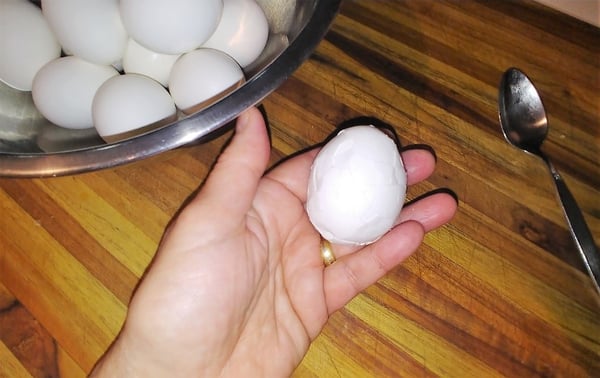 It’s time to make the tea liquid. Place the 10 cups of cold water, soy sauce and sugars in the pot. Heat the mixture to just boiling, stirring until the sugar is dissolved. Reduce the heat and add all remaining ingredients, giving everything a good stir to blend. If your tea bags have strings like mine did, gather the strings together and wrap them around the handle of your pot to keep you from having to fish them out later. This is not a necessary stop, just a convenient one!
It’s time to make the tea liquid. Place the 10 cups of cold water, soy sauce and sugars in the pot. Heat the mixture to just boiling, stirring until the sugar is dissolved. Reduce the heat and add all remaining ingredients, giving everything a good stir to blend. If your tea bags have strings like mine did, gather the strings together and wrap them around the handle of your pot to keep you from having to fish them out later. This is not a necessary stop, just a convenient one!
Make sure your tea liquid is at a light simmer. Using a slotted spoon or spider, add the crackled eggs into the pot. The tea liquid should cover the eggs. If the eggs are not covered, add hot water to just cover them.
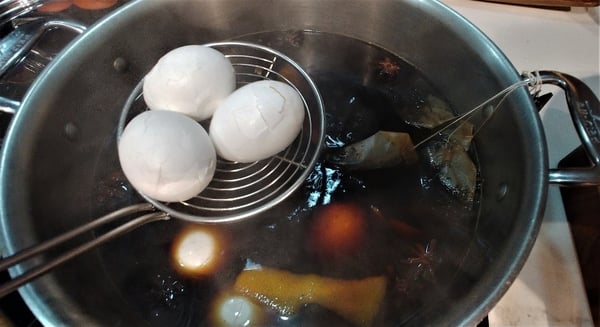 Return the liquid to a light simmer, cover the pot and continue simmering for 10 minutes.
Return the liquid to a light simmer, cover the pot and continue simmering for 10 minutes.
Once done, uncover the pot and remove it from heat. Let the eggs steep in the tea liquid, uncovered, until completely cool. If you are going to eat the eggs immediately, you can dry them off (I suggest paper towels, since the tea liquid will stain fabric) and peel them. Isn’t the marbled result fantastic?
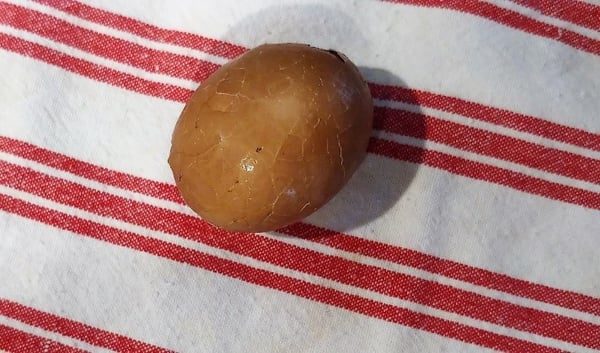
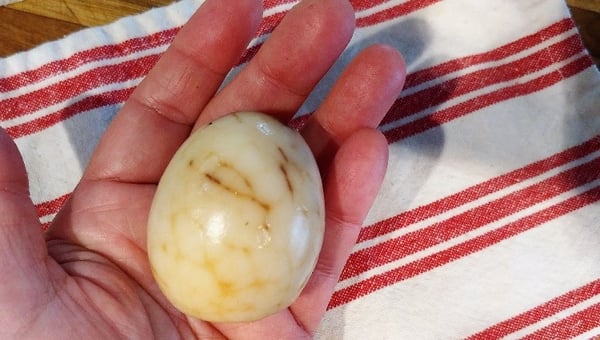 You may chill the eggs in the liquid for up to three days. I usually put the eggs and liquid (along with all the ingredients except the tea bags) in containers instead of putting the whole pot in the fridge. Once you remove the eggs, the liquid can be strained, frozen and reused, if desired.
You may chill the eggs in the liquid for up to three days. I usually put the eggs and liquid (along with all the ingredients except the tea bags) in containers instead of putting the whole pot in the fridge. Once you remove the eggs, the liquid can be strained, frozen and reused, if desired.
You may eat these eggs just as they are or use them in any way you would use regular hard-boiled eggs for an additional layer of flavor: think deviled eggs, egg salad or my favorite, in potato salad! I generally set them out alongside my husband’s favorite hot and sour soup as a starter to our celebration dinner. And I always make extra, even if I don’t do anything special with them, leftovers make for a great quick breakfast or snack.
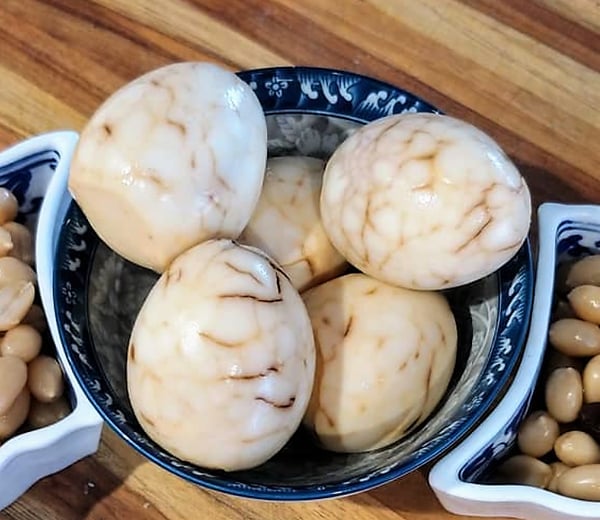 I hope you find these as easy to make and as irresistible to enjoy as I do!
I hope you find these as easy to make and as irresistible to enjoy as I do!
The Chopping Block’s private Facebook group has featured several Chinese New Year dishes lately as part of our TCB Cooking Challenge! Shelley’s Chinese Sausage Fried Rice looks incredible, and there are also my own blog posts from prior years: Stuffed Lotus Root, one of our favorite Chinese desserts, as well as Whole Steamed Fish, which remains one of our favorite ways to enjoy fish, regardless of the season. If you aren't already a member, join now.
For more Asian favorites, don't miss our virtual Southeast Asian Workshop coming up in March, where you will learn how to make:
- Filipino Lumpia (Pork and Cabbage Spring Rolls)
- Vietnamese Lemongrass Chicken Banh Mi Sandwiches with Pickled Vegetables
- Thai Green Papaya Salad

